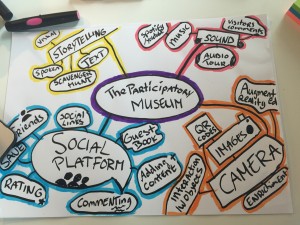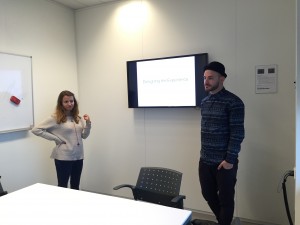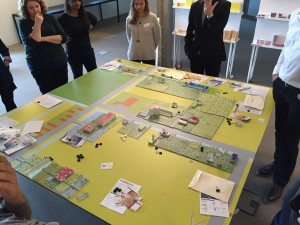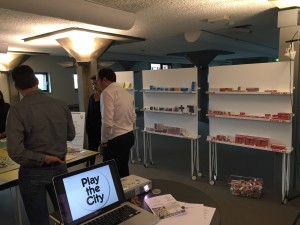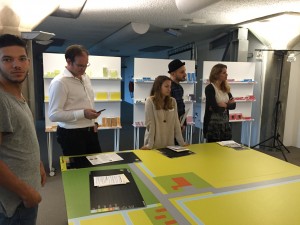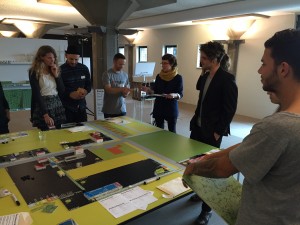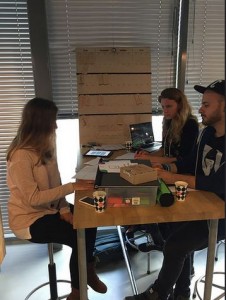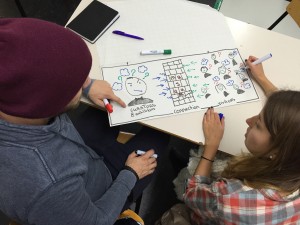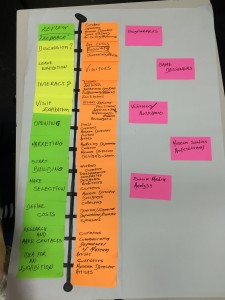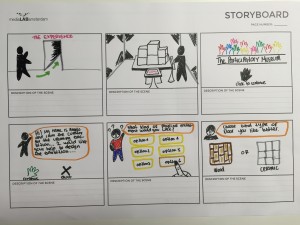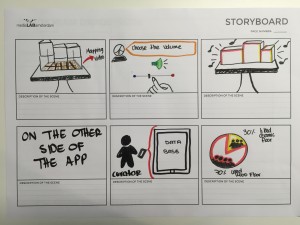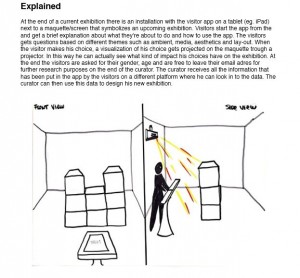We welcome you once again to a fresh new blog post. On our previous post we kept a promise, which was to let you know what happened during the first meeting with our partner No More Mondays. So let’s start from that!
The Meeting
We had the great pleasure to meet Gert-jan Brok and Don Blaauw and present to them (through a presentation) ourselves and most important our ideas so far around the project we are working on. On this meeting, there was also present our coach and stakeholder Bernadette Schrandt, while it was important for her also to see which are the findings, approach, and results of our work so far. In general our main idea was centered around an interesting and valuable publication we found by the scholar Nina Simon, entitled The Participatory Museum (2010) which we think was quite relevant and interesting to examine. Simon formulates her thinking around the incorporation of elements from social media and mainly from Web 2.0 into the museum content, which is possible to lead on the creation of Museum 2.0 as she calls it. Museum 2.0 will allow more participation for the visitors, while it is engaging them into a meaning making creative process which they become part of, through ideas and activities based on co-creation and co-curating. Having this in mind, we made a sketch of our ideas surrounding The Participatory Museum and how these ideas can be applied to our project.
Folllowing our presentation, we had a fruitful discussion all together about the possibilities we have around our creation, with our coach Bernadette Schrandt making clear that our end product needs to be useful for the curators mainly, while our approach so far has been more visitors centered. With this in mind, along with the ideas that both Gert and Don provided us springing from their long working experience and collaboration with museums, by creating games and applications for them, we left this meeting all together in order to move to a different place, which came to be a new source of inspiration.
Time for Play
Bernadette has informed us that we will visit an urban planning/gaming company by the name Play the City, but she didn’t gave us more information about their work, or what we were supposed to do there. At the end, it proved to be a great “surprise” after all. Play the City, is an Amsterdam based company which uses gaming in order to engage multiple stakeholders in resolving complex urban challenges. They believe that is the real alternative to standard formats of public consultation in the 21st century. Their method has been acknowledged internationally and has been implemented for large-scale projects in Amsterdam, Istanbul, Brussels and Cape Town.
Entering the room, you found three tables made from crates on the top of which you could see plenty (sealed) envelopes with different numbers. Every crate table had a different profile, so you could choose one between them (based on construction choices). After choosing, you had to follow the information and rules your choice was giving. Following this, we moved to the main gaming room. There, after a brief presentation of the company’s role and achievements so far along with information about the rules of the game, we were allowed to open our “secret” envelopes. Inside these envelopes there were money specially designed for this game. The game was taking place on a big table, which had a designed interface (imagine a big sticker on a table) of a landscape in Almere, which they want to develop. All around the table there were shelves- stands from which you could buy any kind of buildings, agriculture, water supply, electricity supply etc. all in the form of small miniatures. Depending on your money and profile , you had specific choices that you could make. Thus, it was always possible to collaborate with your neighboors or ask their help when you couldnt buy something solely.
From our team, Angela decided to build a students residence, while I decided to build an Art Factory that could host artists so to experiment and make theirs creations. However, Angelo went towards a more “kinky” direction by creating a big “Vegas type” of area, where people could have fun in many ways. (Unfortunately, at the end he didn’t finished his idea while he was left broke). All in all, it was a really inspiring experience and the people working for the company were very kind and helpful with our questions and struggles we faced during the game. The main thing we realized through this experience is how you can simplify big problems with the use of gaming platforms and gaming thinking (Gamification). Something similar is what we have to achieve for our project, while the needs of both curators and visitors are so many globally, which makes the problem we need to solve, big as well.
Translate Session and New Concept
After this meeting, the next days that followed were all about work, work and work, including a lot of discussion around possible concepts. Wednesday was an important day which came to make our concept clearer. During our first Translate session with Bernadette Schrandt, we discussed our findings so far, what still needs to be done and possible goals for our next sprint session. After our meeting, we had a clearer idea of what we would like to do. Felipe Escobar who is working for MediaLab as an industrial and multimedia designer, helped us a lot on the definition of a clear concept, by showing us some very interesting videos based on 3D project mapping and Augmented Reality with the use of cards. After this, we start thinking how these concepts could be applied to our own. Also it was really helpful for us in order to define our stakeholders better along with our concept a workshop we attended entitled Define Interventions provided by Charlie Mulholland.
As you can see from the images that follow, we decided that we would like to create a 3D mapping projection on a physical interface that can be placed inside a museum. Through the use of an application that visitors will use on screens places in front of this interface, they will be able to make their choices for the design of an upcoming exhibition. Their choices then will become visualized on the physical interaface through the use of a projector, an activity that will be taking place in real time and in the same space. This will provide them a visualization of their ideas/choices but on the same time their actions-choices will be transfered- after being translated into data- to the curator, who will be able to see the audiences preferences so to work better on the creation of a new exhibition.
For the formualtion of this concept, we worked all together as a team following the tasks that we have divided in the begining of our Sprint. Angela created an online survey for the public, in order to understand better their needs and preferenes around museums/exhibitions (ditigal or physical, modern or classic art etc.) and along with research that she conducted on visitors studies she created the visitors personas. I conducted four interviews with curators from different museums including FOAM, Het Ship, Het Nieuwe Instituut and Amsterdam Museum, along with research around their profession and decision making for exhibitions, including also their preferences, which helped me to formulate the curators personas. As for Angelo, he was the one who made a clickable prototype for the application that could be used as part of our project, but also formulated our user stories and value proposition always taking account our opinion and final goal.
Unfortunately, the first feedback from Don when we sent him our idea was not what we were expecting, while he characterized it rather broad, with many words and questions for visitors to reply (quite time consuming) and with a need for further explanation, without rejecting it though. On the other hand, our coach Bernadette-after explaining to her better our concept- seemed interested on it, giving us valuable feedback and highlighting aspects that she would like us to give a further focus.
To conclude, we are happy that before the end of our first Sprint we have a concept, one that many need further development, but at least is a first concept that we can work with. On the 1st of October we have a very important meeting with our stakeholders, where we need to present them the results of our research, along with our concept. So far, we have been moving from concept to concept which is quite normal, while we are still in the beginning of our creative journey. We hope that this time our concept will be THE CONCEPT except for us, but also for our stakeholders. Want to know what happened after all? Just wait for our next blog post!! Till then you can always check our Flickr account for visual material. Thank you once again for reading!
Angelo, Angela and Constantine!






